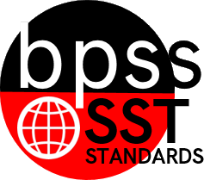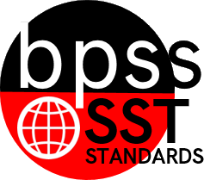SST-02.4
 Standard 4: Standard 4:
Government and Citizenship
Students understand the development, functions, and forms of various political institutions and the role of the citizen in government and society.
|
Narrative for the Government and Citizenship
Through active learning experiences, students in the second grade are able to apply thinking and decision-making skills within the context of their school and neighborhood. Students examine events and changes that might take place in the future. Students demonstrate that neighborhoods around the world are made up of people of diverse ages and backgrounds and explain how family and community members depend upon each other to provide for emotional needs and for goods and services. Students also identify the rights and responsibilities of members of the school and neighborhood and explain why communities have rules and laws. They should have opportunities to engage in problem solving and participate in the development of classroom rules. They should have the opportunity to use a variety of means for gathering and organizing information.
Calculation Method for Standards
Standards are larger groups of related benchmarks. The Standard Grade is a calculation of all the related benchmarks. Click on the benchmark name below each Standard to access the learning targets and proficiency rubrics for each standard's related benchmarks. |
|
SST-02.4.01
|
2nd Grade SST Targeted Benchmarks
Standard 4: Political Systems
SST-02.4.01 Identify roles and responsibilities of leaders in the home, school, and community (e.g., parents, teachers, principal, mayor, governor, president).
|
Student Learning Targets:
Knowledge Targets
- I can list the jobs of the leaders in my home, school, and community.
Proficiency Rubric
| Score |
|
Description |
Sample Activity
|
| 4.0 |
In addition to a proficient score of 3.0, the student demonstrates in-depth understanding and application of knowledge regarding more complex material.
|
- |
| |
3.5 |
In addition to a proficient score of 3.0, the student demonstrates in-depth understanding of knowledge on the content. |
| 3.0 |
The student identifies roles and responsibilities of leaders in the home, school, and community. (e.g., parents, teachers, principal, mayor, governor, president) The student will have all correct answers on the assessment. |
- |
| |
2.5 |
The student demonstrates no major errors or omissions regarding the simpler details and processes (Score 2.0 content) and partial knowledge of the more complex ideas and processes (Score 3.0 content). |
| 2.0 |
The student identifies roles and responsibilities of leaders in the home, school, and community. (e.g., parents, teachers, principal, mayor, governor, president) The student will have no more than two errors on the assessment. |
- |
| |
1.5 |
The student demonstrates partial knowledge of the simpler details and processes (Score 2.0 content) but exhibits major errors or omissions regarding the more complex ideas and procedures (Score 3.0 content). |
| 1.0 |
The student identifies roles and responsibilities of leaders in the home, school, and community. (e.g., parents, teachers, principal, mayor, governor, president) The student will have no more than four errors on the assessment. |
- |
| |
0.5 |
The student will have more than four errors on the assessment. |
Resources
Websites
Discovery Education
Elementary Social Studies
Parents Helping Students
Helping Your Child With Social Studies
Social Studies in Second Grade
Vocabulary
- role
- responsibility
- leader
- home
- school
- community
|
|
SST-02.4.02
|
2nd Grade SST Targeted Benchmarks
Standard 4: Political Systems
SST-02.4.02 Compare the relationship between rules and laws in home, school, and community (e.g., hitting/assault, stealing/larceny).
|
Student Learning Targets:
Knowledge Targets
Reasoning Targets
Skills (Performance) Targets
Product Targets
Proficiency Scale
| Score |
|
Description |
Sample Activity
|
| 4.0 |
In addition to Score 3.0, the student demonstrates in-depth inferences and applications regarding more complex material that go beyond end of instruction expectations. |
- |
| |
3.5 |
In addition to Score 3.0 performance, the student demonstrates in-depth inferences and applications regarding the more complex content with partial success. |
| 3.0 |
“The Standard.” The student demonstrates no major errors or omissions regarding any of the information and processes that were end of instruction expectations. |
- |
| |
2.5 |
The student demonstrates no major errors or omissions regarding the simpler details and processes (Score 2.0 content) and partial knowledge of the more complex ideas and processes (Score 3.0 content). |
| 2.0 |
The student demonstrates no major errors or omissions regarding the simpler details and processes but exhibits major errors or omissions regarding the more complex ideas and processes (Score 3.0 content). |
- |
| |
1.5 |
The student demonstrates partial knowledge of the simpler details and processes (Score 2.0 content) but exhibits major errors or omissions regarding the more complex ideas and procedures (Score 3.0 content). |
| 1.0 |
With help, the student demonstrates a partial understanding of some of the simpler details and processes (Score 2.0 content) and some of the more complex ideas and processes (Score 3.0 content). |
- |
| |
0.5 |
With help, the student demonstrates a partial understanding of some of the simpler details and processes (Score 2.0 content) but not the more complex ideas and processes (Score 3.0 content). |
| 0.0 |
Even with help, the student demonstrates no understanding or skill. |
- |
Resources
Websites
Vocabulary |
|
 BPS District Social Studies Standards Book
BPS District Social Studies Standards Book
 Standard 4:
Standard 4: